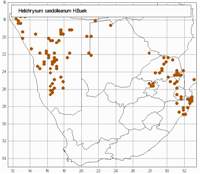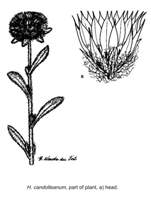Common names:
umaphipha (Z)
Origin of name:
candolleanum = like candollea
Diagnostic characters:
Compact inflorescences with few heads
Large heads
Leaves beneath flower head
Green leaves woolly
Description:
Perennial herb sometimes flowering in seedling stage, taproot stout, woody, crown becoming woody at base with age, main branches c. 150�450 mm long, subsimple to profusely branched, prostrate, decumbent or erect, thinly woolly becoming floccose, leafy. Leaves (4�) 10�35 x (1�) 1.5�8 (�12) mm, linear, oblong-lanceolate, lanceolate, oblanceolate, occasionally narrowly to broadly obovate or spathulate, acute, subacute or obtuse, mucronate, base narrowed, half-clasping, both surfaces thickly to thinly greyish-woolly, often yellowish when young. Heads homogamous, campanulate, c. (4�) 5�6 x 3.5�4 (�6) mm, many in tight globose clusters c. 15�20 mm across at the tips of the branchlets, surrounded by woolly leaves mostly longer than the compound head. Involucral bracts in c. 6 series, subequal, slightly exceeding the flowers, loosely imbricate, very acute to acuminate, radiating, shining, pellucid, silvery white, inner in particular often suffused or tipped pink or crimson, rarely with flecks of colour, tips sometimes subopaque. Receptacle with pit margins shortly produced, or nearly smooth. Flowers 18�50, yellow, tipped red. Achenes 0.75 mm, elliptic, with myxogenic hairs, or rarely glabrous. Pappus bristles many, about equaling corolla, scabrid, bases cohering by patent cilia.
Flowering recorded throughout the year, but mainly between June and September.
Distribution:
Favours sandy or gravelly soils in grassland or open woodland, and open sandy places such as watercourses; sometimes a weed. Widely distributed from Namibia to Botswana, the Bushveld, Swaziland Lowveld, and coastal KwaZulu-Natal as far south as Durban, penetrating inland up the dry river valleys. Also in Zimbabwe, Mozambique and, reputedly, Madagascar (see note under type specimen).
Grassland, Savanna
Notes:
H. candolleanum is very variable in stature, in habit, and in leaf size, shape and degree of woolliness; some of this variation is undoubtedly environmentally controlled, but some is possibly genetic. In Namibia, there is some geographical partitioning of variation, but it seems best to avoid formal recognition of infraspecific groups partly because variation is by no means sharply discontinuous, partly because the situation is not understood; the problems will not yield to herbarium studies.
The commonest form of the species, which occurs throughout the major part of the geographical range, is very woolly, well-branched, the branches short, the leaves mostly 3�5 mm broad, and plants may be prostrate to erect. Plants will flower in the seedling stage and can then look deceptively different, but the small homogamous heads with very acute to acuminate bracts are diagnostic.
In the Kaokoveld of NW. Namibia and nearby parts of Angola, plants are more or less erect and subshrubby with long slender branches and narrow (1�2 mm) leaves. Similar plants occur sporadically together with the more or less prostrate form southwards to about the 24th parallel in Namibia and as far east as Gauteng and Tongaland.
The 'leggy' plants have been segregated as H. riparium Brenan (Merxm., F.S.W.A. 139: 97, 1967). The diagnostic feature of H. riparium, as emphasized by Brenan, is the crisped-undulate reflexed involucral bracts: some specimens from NW. Namibia certainly have the inner, young, bracts somewhat crisped, and outer bracts reflexed, but not more so than many other specimens of H. candolleanum over its geographical range: they seem to be no more than a variant of H. candolleanum. Field studies are desirable to ascertain the status of these plants and of H. riparium.
Plants with broad, exceedingly woolly leaves are found around Otavi, in the Waterberg, and nearby; these were segregated as var. intermedium and var. latifolium.
Taxonomy:
Literature:
Helichrysum candolleanum Buek, Index DC. Prodr. 2: vi (Oct. 1840); Hilliard, Compositae in Natal 211 (1977).
Type:
Bojer 15 (G-DC, holo.; P, fragment, iso.) (cited by De Candolle as collected in Madagascar, but stated by Humbert, Fl. Madag. Comp. 565, 1962, to have come from E. Africa).
Synonym(s):
H. leptolepis DC., Prodr. 6: 170 (1838), non DC., Prodr. 6: 194 (1838); Harv. in F. C. 3: 222 (1865); Moeser in Bot. Jb. 44: 303 (1910); Merxm., F. S. W. A. 139: 95 (1967). H. detersum Steud., Nom, edn 2,1: 738 (Nov. 1840). Gnaphalium candolleanum (Buek) Sch. Bip. in Bot. Ztg 3: 169 (1845). G. leptolepis (DC.) Kuntze, Rev. Gen. Pl. 3,2: 152 (1898). Type as for H. candolleanum.
H. pachyrhizum Harv. in F. C. 3: 222 (1865), nom. illegit., excl. var. � thunbergii Harv. Lectotype: Gauteng, Aapies River, Zeyher 895 (K, B; BM; BOL; E; SAM, isolecto.).
H. damarense O. Hoffm. in Bot. Jb. 10: 275 (1889). Type: Namibia, Karibib, Marloth 1287 (PRE, iso.).
H. leptolepis var. intermedium S. Moore in Bull. Herbarium Boissier 2 s�r. 4: 1016 (1904). Type: Namibia, Otavi, Dinter 557 p.p. (Z, holo.; BM, iso.).
H. leptolepis var. latifolium S. Moore, l.c. Type: Namibia, Waterberg Plateau, Dinter 557 p.p. (Z, holo.; BM, iso.).
Vouchers:
Acocks 18105 (PRE); Compton 26959 (NBG; PRE); Giess 8996 (M; NBG; PRE; WIND); Merxmuller & Giess 30527 (M; PRE; WIND); De Winter & Leistner 5805 (K; M; PRE; WIND); Giess 12392 (PRE; WIND).


_sml.jpg)
_sml.jpg)
_sml.jpg)
_sml.jpg)

